Business Skills: E-commerce Solutions and Sainsbury's Stakeholder Aims
VerifiedAdded on 2023/04/07
|20
|5906
|483
Report
AI Summary
This report assesses Sainsbury's core business functions and evaluates its aims in relation to stakeholders. It analyzes the positive and negative impacts of e-commerce on Sainsbury and discusses the global impact of e-commerce. The report investigates the market potential for e-commerce opportunities, evaluates current e-commerce systems used by competitors, and discusses the financial implications of e-commerce solutions. Furthermore, it designs an e-commerce solution to enhance Sainsbury's business functions and evaluates its suitability. This detailed analysis provides a comprehensive understanding of Sainsbury's business skills and e-commerce strategies.
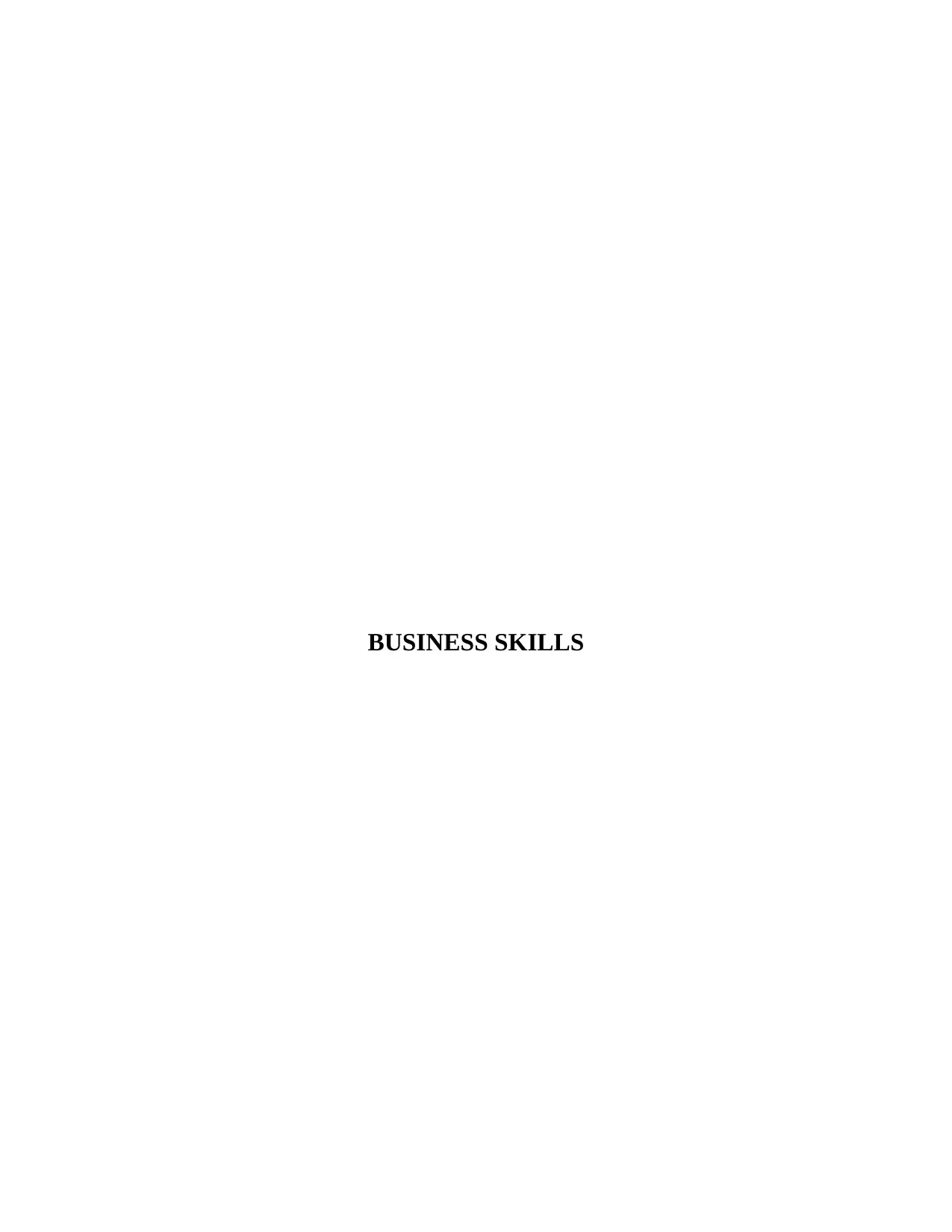
BUSINESS SKILLS
Paraphrase This Document
Need a fresh take? Get an instant paraphrase of this document with our AI Paraphraser
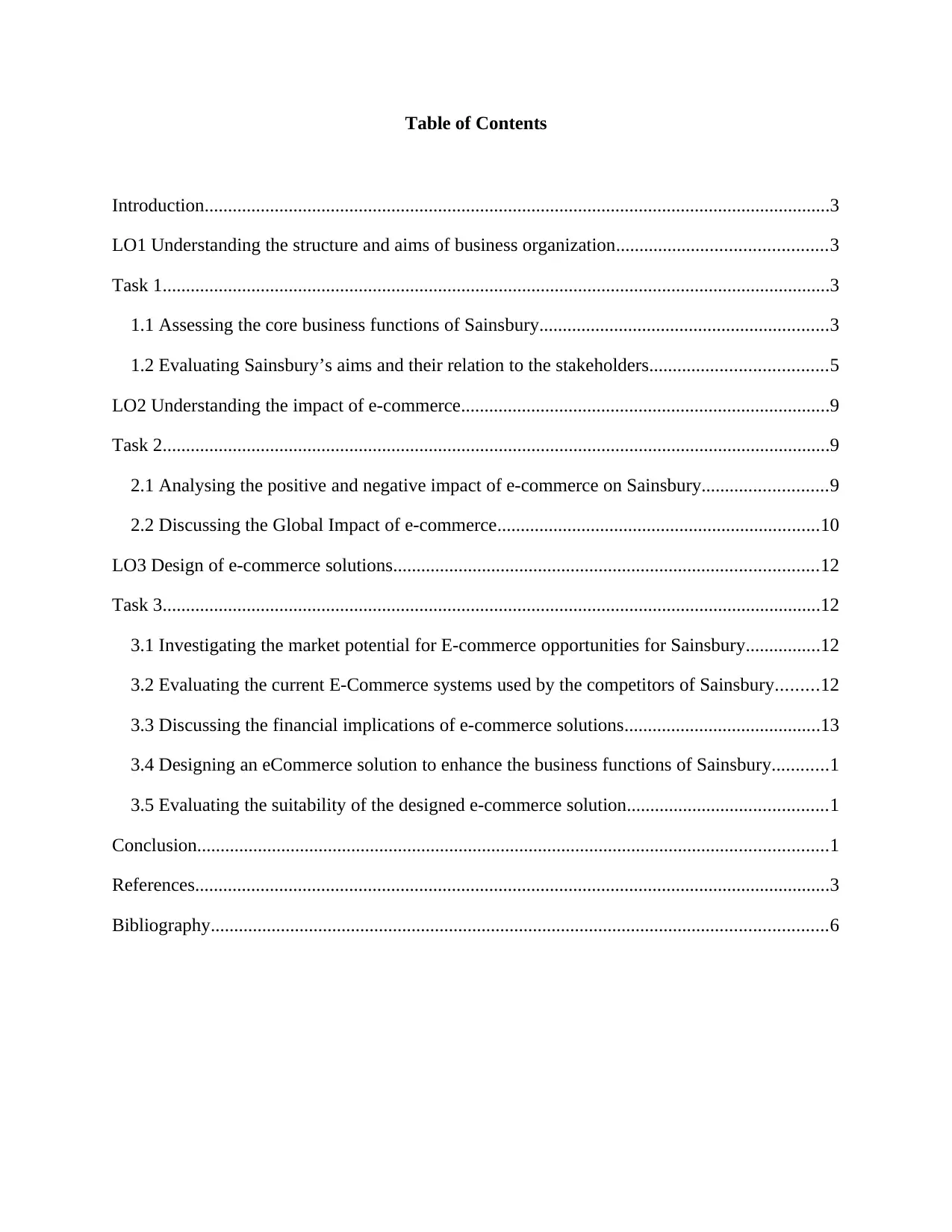
Table of Contents
Introduction......................................................................................................................................3
LO1 Understanding the structure and aims of business organization.............................................3
Task 1...............................................................................................................................................3
1.1 Assessing the core business functions of Sainsbury..............................................................3
1.2 Evaluating Sainsbury’s aims and their relation to the stakeholders......................................5
LO2 Understanding the impact of e-commerce...............................................................................9
Task 2...............................................................................................................................................9
2.1 Analysing the positive and negative impact of e-commerce on Sainsbury...........................9
2.2 Discussing the Global Impact of e-commerce.....................................................................10
LO3 Design of e-commerce solutions...........................................................................................12
Task 3.............................................................................................................................................12
3.1 Investigating the market potential for E-commerce opportunities for Sainsbury................12
3.2 Evaluating the current E-Commerce systems used by the competitors of Sainsbury.........12
3.3 Discussing the financial implications of e-commerce solutions..........................................13
3.4 Designing an eCommerce solution to enhance the business functions of Sainsbury............1
3.5 Evaluating the suitability of the designed e-commerce solution...........................................1
Conclusion.......................................................................................................................................1
References........................................................................................................................................3
Bibliography....................................................................................................................................6
Introduction......................................................................................................................................3
LO1 Understanding the structure and aims of business organization.............................................3
Task 1...............................................................................................................................................3
1.1 Assessing the core business functions of Sainsbury..............................................................3
1.2 Evaluating Sainsbury’s aims and their relation to the stakeholders......................................5
LO2 Understanding the impact of e-commerce...............................................................................9
Task 2...............................................................................................................................................9
2.1 Analysing the positive and negative impact of e-commerce on Sainsbury...........................9
2.2 Discussing the Global Impact of e-commerce.....................................................................10
LO3 Design of e-commerce solutions...........................................................................................12
Task 3.............................................................................................................................................12
3.1 Investigating the market potential for E-commerce opportunities for Sainsbury................12
3.2 Evaluating the current E-Commerce systems used by the competitors of Sainsbury.........12
3.3 Discussing the financial implications of e-commerce solutions..........................................13
3.4 Designing an eCommerce solution to enhance the business functions of Sainsbury............1
3.5 Evaluating the suitability of the designed e-commerce solution...........................................1
Conclusion.......................................................................................................................................1
References........................................................................................................................................3
Bibliography....................................................................................................................................6
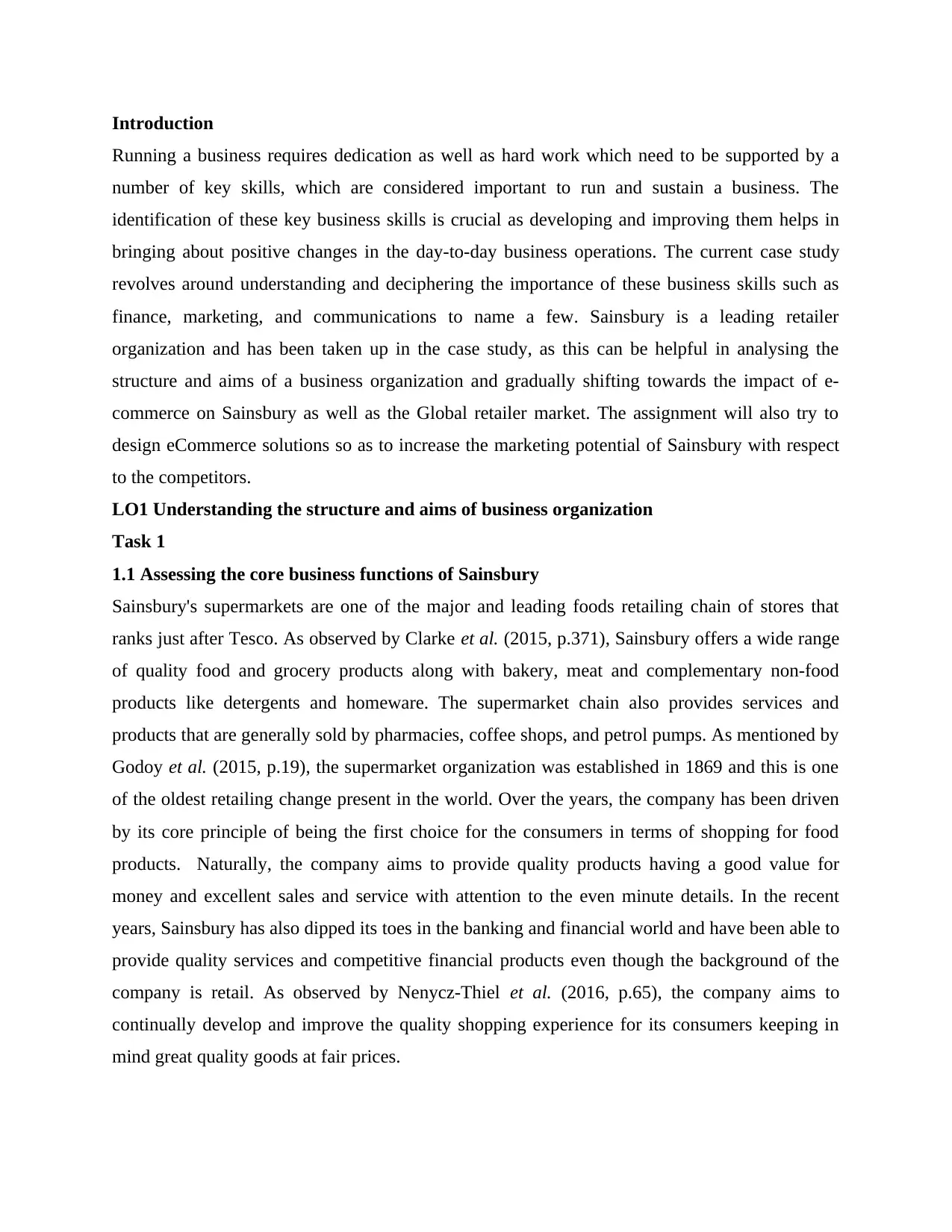
Introduction
Running a business requires dedication as well as hard work which need to be supported by a
number of key skills, which are considered important to run and sustain a business. The
identification of these key business skills is crucial as developing and improving them helps in
bringing about positive changes in the day-to-day business operations. The current case study
revolves around understanding and deciphering the importance of these business skills such as
finance, marketing, and communications to name a few. Sainsbury is a leading retailer
organization and has been taken up in the case study, as this can be helpful in analysing the
structure and aims of a business organization and gradually shifting towards the impact of e-
commerce on Sainsbury as well as the Global retailer market. The assignment will also try to
design eCommerce solutions so as to increase the marketing potential of Sainsbury with respect
to the competitors.
LO1 Understanding the structure and aims of business organization
Task 1
1.1 Assessing the core business functions of Sainsbury
Sainsbury's supermarkets are one of the major and leading foods retailing chain of stores that
ranks just after Tesco. As observed by Clarke et al. (2015, p.371), Sainsbury offers a wide range
of quality food and grocery products along with bakery, meat and complementary non-food
products like detergents and homeware. The supermarket chain also provides services and
products that are generally sold by pharmacies, coffee shops, and petrol pumps. As mentioned by
Godoy et al. (2015, p.19), the supermarket organization was established in 1869 and this is one
of the oldest retailing change present in the world. Over the years, the company has been driven
by its core principle of being the first choice for the consumers in terms of shopping for food
products. Naturally, the company aims to provide quality products having a good value for
money and excellent sales and service with attention to the even minute details. In the recent
years, Sainsbury has also dipped its toes in the banking and financial world and have been able to
provide quality services and competitive financial products even though the background of the
company is retail. As observed by Nenycz-Thiel et al. (2016, p.65), the company aims to
continually develop and improve the quality shopping experience for its consumers keeping in
mind great quality goods at fair prices.
Running a business requires dedication as well as hard work which need to be supported by a
number of key skills, which are considered important to run and sustain a business. The
identification of these key business skills is crucial as developing and improving them helps in
bringing about positive changes in the day-to-day business operations. The current case study
revolves around understanding and deciphering the importance of these business skills such as
finance, marketing, and communications to name a few. Sainsbury is a leading retailer
organization and has been taken up in the case study, as this can be helpful in analysing the
structure and aims of a business organization and gradually shifting towards the impact of e-
commerce on Sainsbury as well as the Global retailer market. The assignment will also try to
design eCommerce solutions so as to increase the marketing potential of Sainsbury with respect
to the competitors.
LO1 Understanding the structure and aims of business organization
Task 1
1.1 Assessing the core business functions of Sainsbury
Sainsbury's supermarkets are one of the major and leading foods retailing chain of stores that
ranks just after Tesco. As observed by Clarke et al. (2015, p.371), Sainsbury offers a wide range
of quality food and grocery products along with bakery, meat and complementary non-food
products like detergents and homeware. The supermarket chain also provides services and
products that are generally sold by pharmacies, coffee shops, and petrol pumps. As mentioned by
Godoy et al. (2015, p.19), the supermarket organization was established in 1869 and this is one
of the oldest retailing change present in the world. Over the years, the company has been driven
by its core principle of being the first choice for the consumers in terms of shopping for food
products. Naturally, the company aims to provide quality products having a good value for
money and excellent sales and service with attention to the even minute details. In the recent
years, Sainsbury has also dipped its toes in the banking and financial world and have been able to
provide quality services and competitive financial products even though the background of the
company is retail. As observed by Nenycz-Thiel et al. (2016, p.65), the company aims to
continually develop and improve the quality shopping experience for its consumers keeping in
mind great quality goods at fair prices.
⊘ This is a preview!⊘
Do you want full access?
Subscribe today to unlock all pages.

Trusted by 1+ million students worldwide
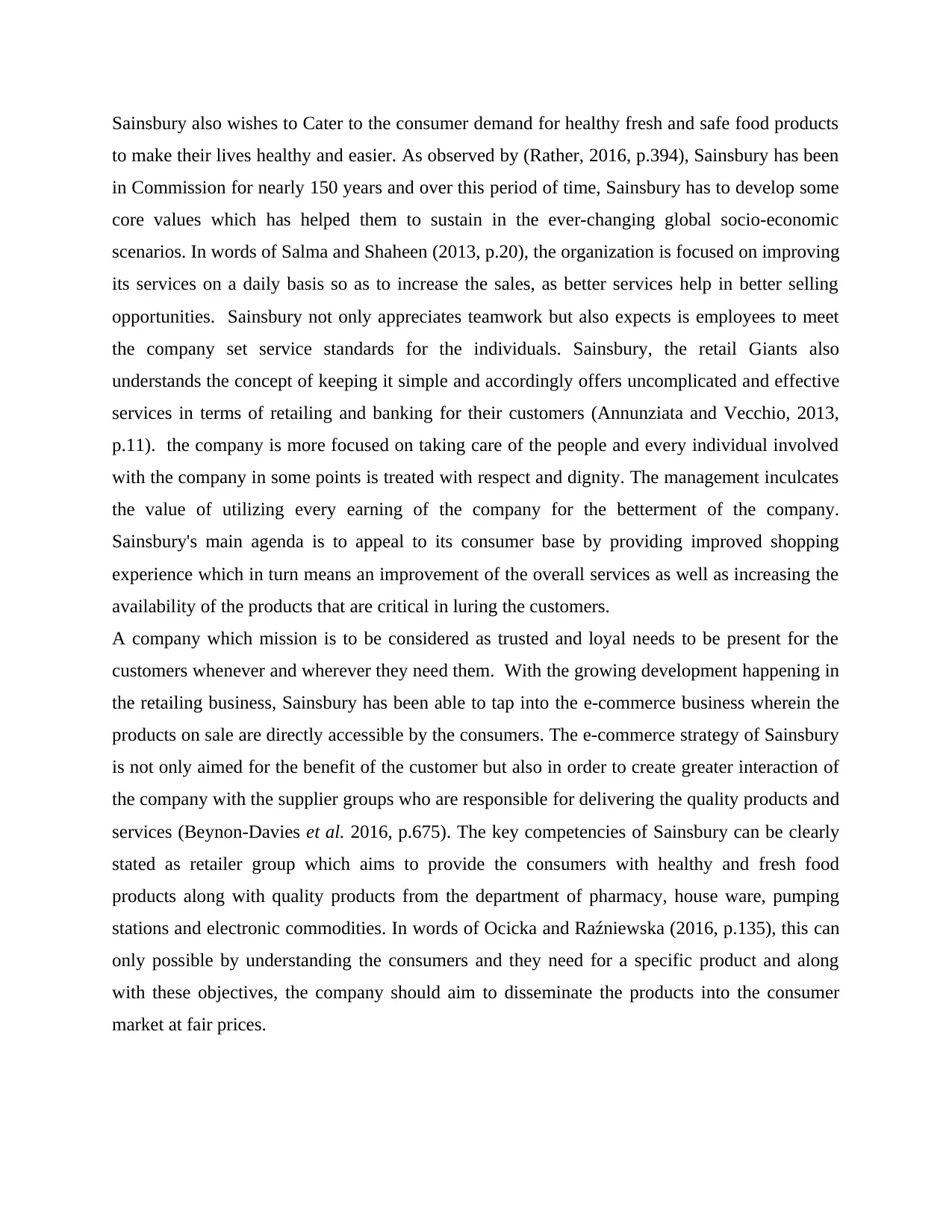
Sainsbury also wishes to Cater to the consumer demand for healthy fresh and safe food products
to make their lives healthy and easier. As observed by (Rather, 2016, p.394), Sainsbury has been
in Commission for nearly 150 years and over this period of time, Sainsbury has to develop some
core values which has helped them to sustain in the ever-changing global socio-economic
scenarios. In words of Salma and Shaheen (2013, p.20), the organization is focused on improving
its services on a daily basis so as to increase the sales, as better services help in better selling
opportunities. Sainsbury not only appreciates teamwork but also expects is employees to meet
the company set service standards for the individuals. Sainsbury, the retail Giants also
understands the concept of keeping it simple and accordingly offers uncomplicated and effective
services in terms of retailing and banking for their customers (Annunziata and Vecchio, 2013,
p.11). the company is more focused on taking care of the people and every individual involved
with the company in some points is treated with respect and dignity. The management inculcates
the value of utilizing every earning of the company for the betterment of the company.
Sainsbury's main agenda is to appeal to its consumer base by providing improved shopping
experience which in turn means an improvement of the overall services as well as increasing the
availability of the products that are critical in luring the customers.
A company which mission is to be considered as trusted and loyal needs to be present for the
customers whenever and wherever they need them. With the growing development happening in
the retailing business, Sainsbury has been able to tap into the e-commerce business wherein the
products on sale are directly accessible by the consumers. The e-commerce strategy of Sainsbury
is not only aimed for the benefit of the customer but also in order to create greater interaction of
the company with the supplier groups who are responsible for delivering the quality products and
services (Beynon-Davies et al. 2016, p.675). The key competencies of Sainsbury can be clearly
stated as retailer group which aims to provide the consumers with healthy and fresh food
products along with quality products from the department of pharmacy, house ware, pumping
stations and electronic commodities. In words of Ocicka and Raźniewska (2016, p.135), this can
only possible by understanding the consumers and they need for a specific product and along
with these objectives, the company should aim to disseminate the products into the consumer
market at fair prices.
to make their lives healthy and easier. As observed by (Rather, 2016, p.394), Sainsbury has been
in Commission for nearly 150 years and over this period of time, Sainsbury has to develop some
core values which has helped them to sustain in the ever-changing global socio-economic
scenarios. In words of Salma and Shaheen (2013, p.20), the organization is focused on improving
its services on a daily basis so as to increase the sales, as better services help in better selling
opportunities. Sainsbury not only appreciates teamwork but also expects is employees to meet
the company set service standards for the individuals. Sainsbury, the retail Giants also
understands the concept of keeping it simple and accordingly offers uncomplicated and effective
services in terms of retailing and banking for their customers (Annunziata and Vecchio, 2013,
p.11). the company is more focused on taking care of the people and every individual involved
with the company in some points is treated with respect and dignity. The management inculcates
the value of utilizing every earning of the company for the betterment of the company.
Sainsbury's main agenda is to appeal to its consumer base by providing improved shopping
experience which in turn means an improvement of the overall services as well as increasing the
availability of the products that are critical in luring the customers.
A company which mission is to be considered as trusted and loyal needs to be present for the
customers whenever and wherever they need them. With the growing development happening in
the retailing business, Sainsbury has been able to tap into the e-commerce business wherein the
products on sale are directly accessible by the consumers. The e-commerce strategy of Sainsbury
is not only aimed for the benefit of the customer but also in order to create greater interaction of
the company with the supplier groups who are responsible for delivering the quality products and
services (Beynon-Davies et al. 2016, p.675). The key competencies of Sainsbury can be clearly
stated as retailer group which aims to provide the consumers with healthy and fresh food
products along with quality products from the department of pharmacy, house ware, pumping
stations and electronic commodities. In words of Ocicka and Raźniewska (2016, p.135), this can
only possible by understanding the consumers and they need for a specific product and along
with these objectives, the company should aim to disseminate the products into the consumer
market at fair prices.
Paraphrase This Document
Need a fresh take? Get an instant paraphrase of this document with our AI Paraphraser
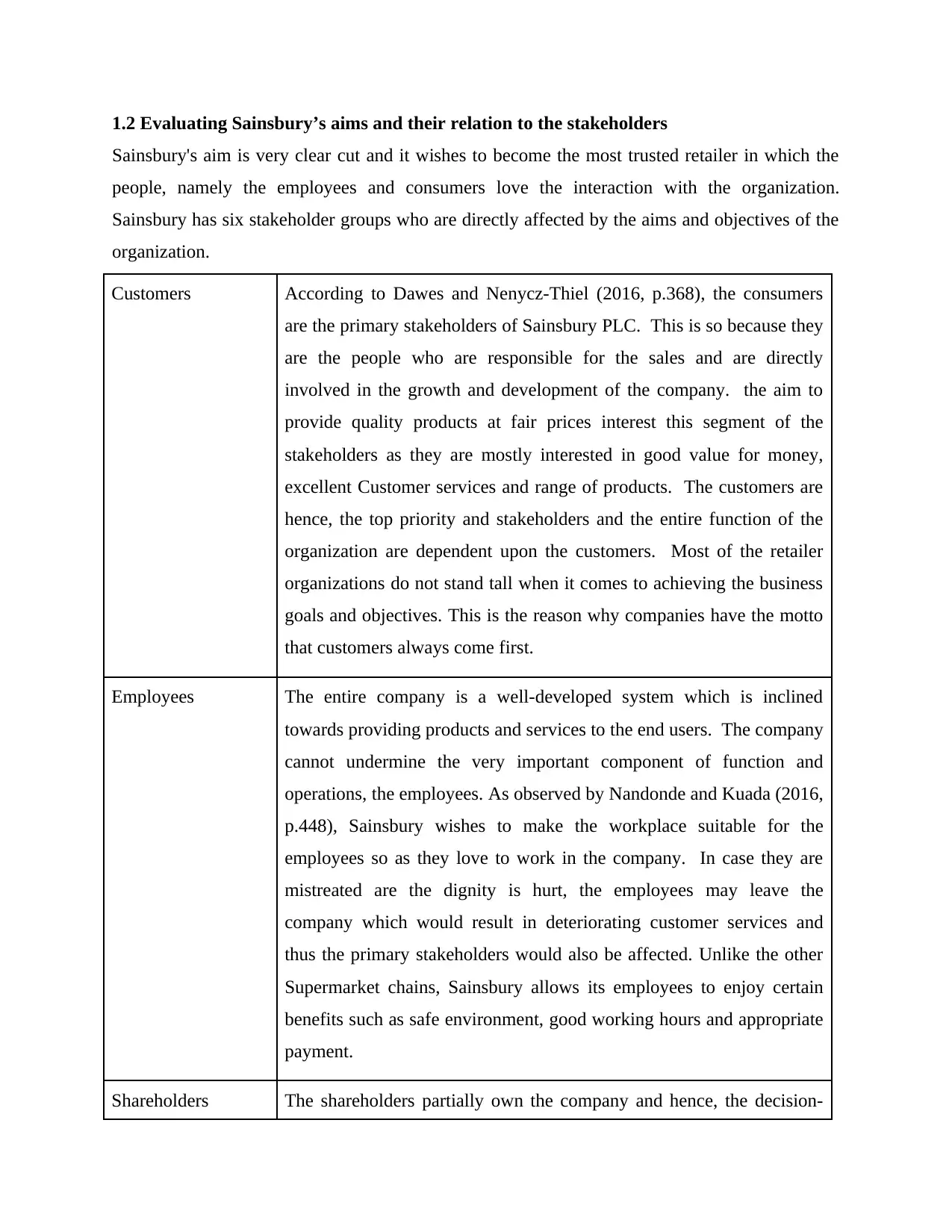
1.2 Evaluating Sainsbury’s aims and their relation to the stakeholders
Sainsbury's aim is very clear cut and it wishes to become the most trusted retailer in which the
people, namely the employees and consumers love the interaction with the organization.
Sainsbury has six stakeholder groups who are directly affected by the aims and objectives of the
organization.
Customers According to Dawes and Nenycz-Thiel (2016, p.368), the consumers
are the primary stakeholders of Sainsbury PLC. This is so because they
are the people who are responsible for the sales and are directly
involved in the growth and development of the company. the aim to
provide quality products at fair prices interest this segment of the
stakeholders as they are mostly interested in good value for money,
excellent Customer services and range of products. The customers are
hence, the top priority and stakeholders and the entire function of the
organization are dependent upon the customers. Most of the retailer
organizations do not stand tall when it comes to achieving the business
goals and objectives. This is the reason why companies have the motto
that customers always come first.
Employees The entire company is a well-developed system which is inclined
towards providing products and services to the end users. The company
cannot undermine the very important component of function and
operations, the employees. As observed by Nandonde and Kuada (2016,
p.448), Sainsbury wishes to make the workplace suitable for the
employees so as they love to work in the company. In case they are
mistreated are the dignity is hurt, the employees may leave the
company which would result in deteriorating customer services and
thus the primary stakeholders would also be affected. Unlike the other
Supermarket chains, Sainsbury allows its employees to enjoy certain
benefits such as safe environment, good working hours and appropriate
payment.
Shareholders The shareholders partially own the company and hence, the decision-
Sainsbury's aim is very clear cut and it wishes to become the most trusted retailer in which the
people, namely the employees and consumers love the interaction with the organization.
Sainsbury has six stakeholder groups who are directly affected by the aims and objectives of the
organization.
Customers According to Dawes and Nenycz-Thiel (2016, p.368), the consumers
are the primary stakeholders of Sainsbury PLC. This is so because they
are the people who are responsible for the sales and are directly
involved in the growth and development of the company. the aim to
provide quality products at fair prices interest this segment of the
stakeholders as they are mostly interested in good value for money,
excellent Customer services and range of products. The customers are
hence, the top priority and stakeholders and the entire function of the
organization are dependent upon the customers. Most of the retailer
organizations do not stand tall when it comes to achieving the business
goals and objectives. This is the reason why companies have the motto
that customers always come first.
Employees The entire company is a well-developed system which is inclined
towards providing products and services to the end users. The company
cannot undermine the very important component of function and
operations, the employees. As observed by Nandonde and Kuada (2016,
p.448), Sainsbury wishes to make the workplace suitable for the
employees so as they love to work in the company. In case they are
mistreated are the dignity is hurt, the employees may leave the
company which would result in deteriorating customer services and
thus the primary stakeholders would also be affected. Unlike the other
Supermarket chains, Sainsbury allows its employees to enjoy certain
benefits such as safe environment, good working hours and appropriate
payment.
Shareholders The shareholders partially own the company and hence, the decision-
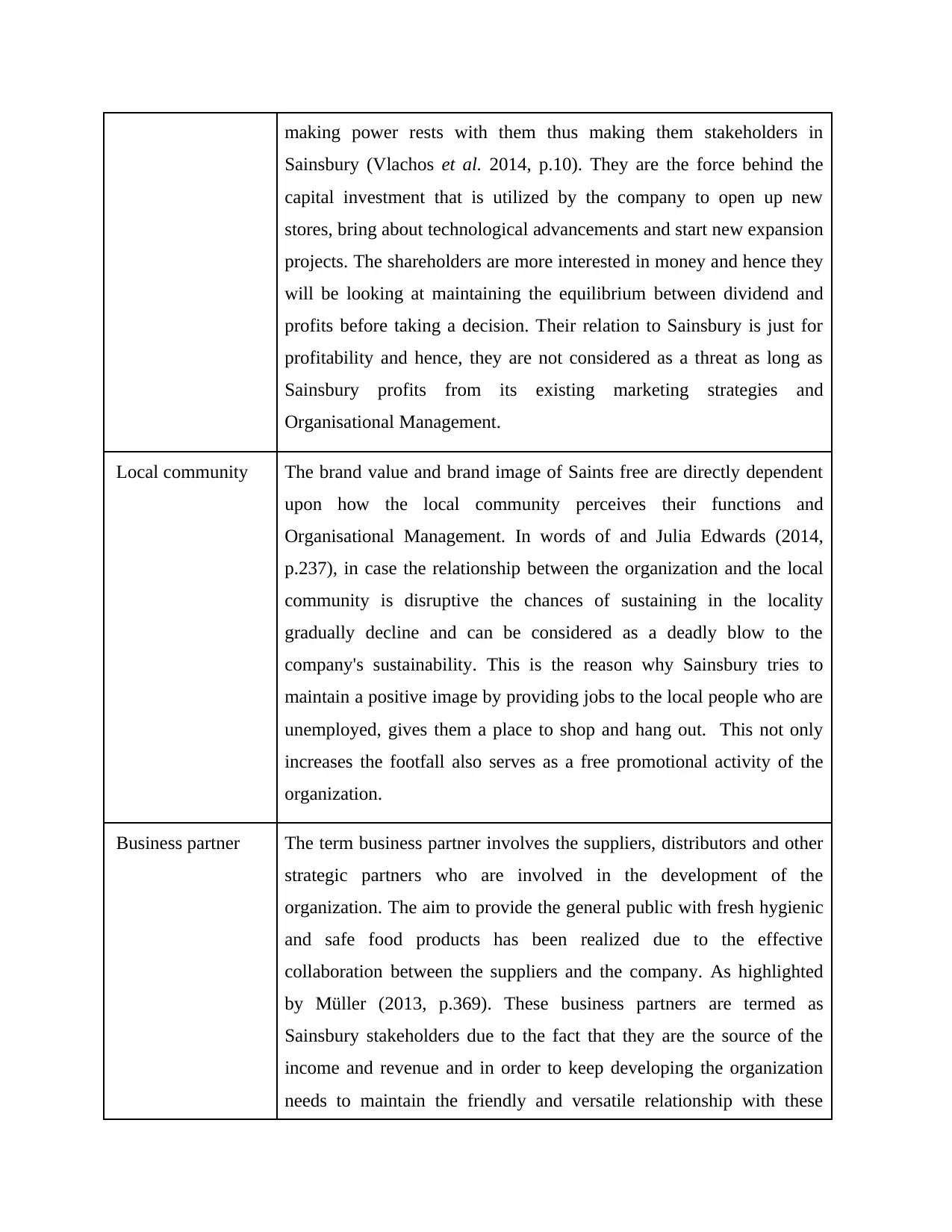
making power rests with them thus making them stakeholders in
Sainsbury (Vlachos et al. 2014, p.10). They are the force behind the
capital investment that is utilized by the company to open up new
stores, bring about technological advancements and start new expansion
projects. The shareholders are more interested in money and hence they
will be looking at maintaining the equilibrium between dividend and
profits before taking a decision. Their relation to Sainsbury is just for
profitability and hence, they are not considered as a threat as long as
Sainsbury profits from its existing marketing strategies and
Organisational Management.
Local community The brand value and brand image of Saints free are directly dependent
upon how the local community perceives their functions and
Organisational Management. In words of and Julia Edwards (2014,
p.237), in case the relationship between the organization and the local
community is disruptive the chances of sustaining in the locality
gradually decline and can be considered as a deadly blow to the
company's sustainability. This is the reason why Sainsbury tries to
maintain a positive image by providing jobs to the local people who are
unemployed, gives them a place to shop and hang out. This not only
increases the footfall also serves as a free promotional activity of the
organization.
Business partner The term business partner involves the suppliers, distributors and other
strategic partners who are involved in the development of the
organization. The aim to provide the general public with fresh hygienic
and safe food products has been realized due to the effective
collaboration between the suppliers and the company. As highlighted
by Müller (2013, p.369). These business partners are termed as
Sainsbury stakeholders due to the fact that they are the source of the
income and revenue and in order to keep developing the organization
needs to maintain the friendly and versatile relationship with these
Sainsbury (Vlachos et al. 2014, p.10). They are the force behind the
capital investment that is utilized by the company to open up new
stores, bring about technological advancements and start new expansion
projects. The shareholders are more interested in money and hence they
will be looking at maintaining the equilibrium between dividend and
profits before taking a decision. Their relation to Sainsbury is just for
profitability and hence, they are not considered as a threat as long as
Sainsbury profits from its existing marketing strategies and
Organisational Management.
Local community The brand value and brand image of Saints free are directly dependent
upon how the local community perceives their functions and
Organisational Management. In words of and Julia Edwards (2014,
p.237), in case the relationship between the organization and the local
community is disruptive the chances of sustaining in the locality
gradually decline and can be considered as a deadly blow to the
company's sustainability. This is the reason why Sainsbury tries to
maintain a positive image by providing jobs to the local people who are
unemployed, gives them a place to shop and hang out. This not only
increases the footfall also serves as a free promotional activity of the
organization.
Business partner The term business partner involves the suppliers, distributors and other
strategic partners who are involved in the development of the
organization. The aim to provide the general public with fresh hygienic
and safe food products has been realized due to the effective
collaboration between the suppliers and the company. As highlighted
by Müller (2013, p.369). These business partners are termed as
Sainsbury stakeholders due to the fact that they are the source of the
income and revenue and in order to keep developing the organization
needs to maintain the friendly and versatile relationship with these
⊘ This is a preview!⊘
Do you want full access?
Subscribe today to unlock all pages.

Trusted by 1+ million students worldwide
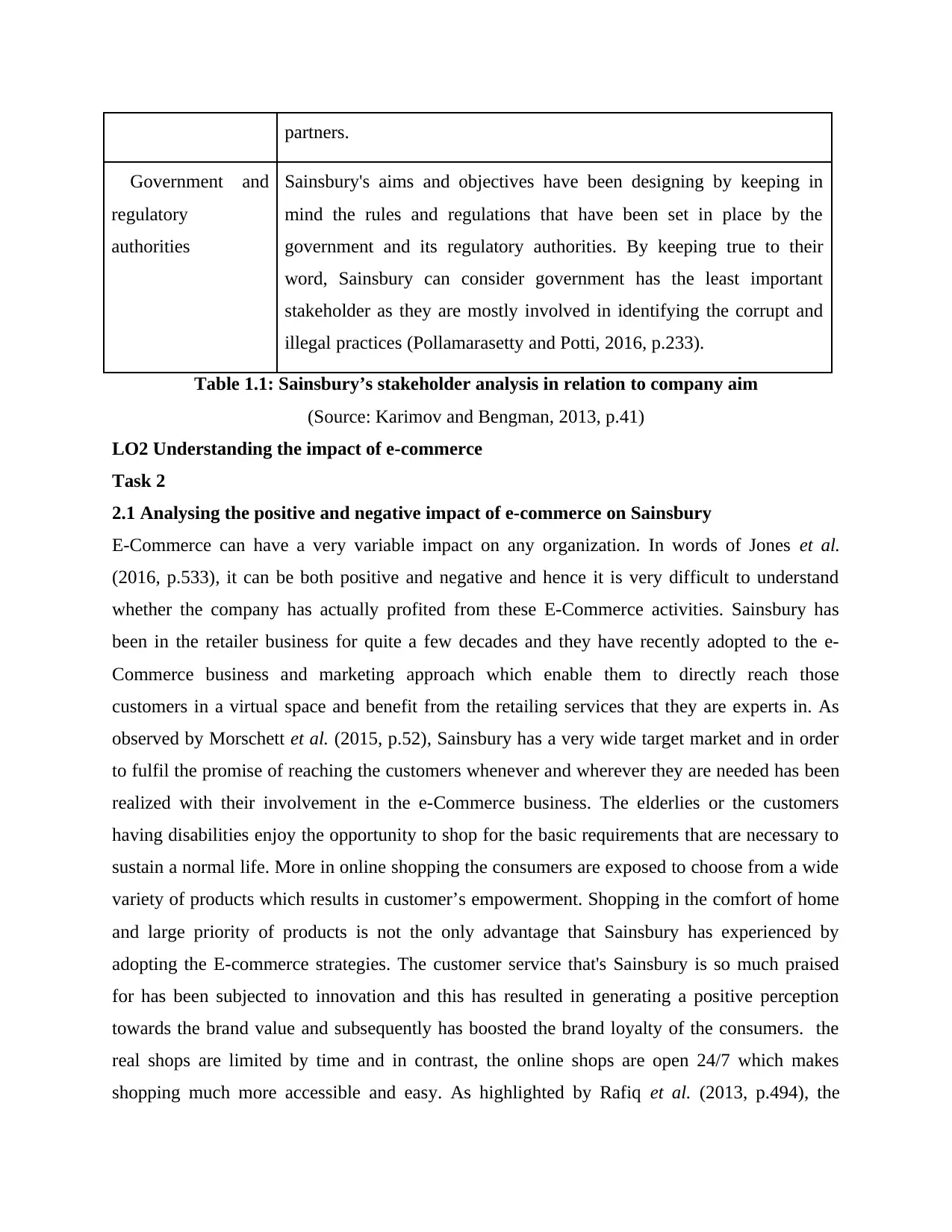
partners.
Government and
regulatory
authorities
Sainsbury's aims and objectives have been designing by keeping in
mind the rules and regulations that have been set in place by the
government and its regulatory authorities. By keeping true to their
word, Sainsbury can consider government has the least important
stakeholder as they are mostly involved in identifying the corrupt and
illegal practices (Pollamarasetty and Potti, 2016, p.233).
Table 1.1: Sainsbury’s stakeholder analysis in relation to company aim
(Source: Karimov and Bengman, 2013, p.41)
LO2 Understanding the impact of e-commerce
Task 2
2.1 Analysing the positive and negative impact of e-commerce on Sainsbury
E-Commerce can have a very variable impact on any organization. In words of Jones et al.
(2016, p.533), it can be both positive and negative and hence it is very difficult to understand
whether the company has actually profited from these E-Commerce activities. Sainsbury has
been in the retailer business for quite a few decades and they have recently adopted to the e-
Commerce business and marketing approach which enable them to directly reach those
customers in a virtual space and benefit from the retailing services that they are experts in. As
observed by Morschett et al. (2015, p.52), Sainsbury has a very wide target market and in order
to fulfil the promise of reaching the customers whenever and wherever they are needed has been
realized with their involvement in the e-Commerce business. The elderlies or the customers
having disabilities enjoy the opportunity to shop for the basic requirements that are necessary to
sustain a normal life. More in online shopping the consumers are exposed to choose from a wide
variety of products which results in customer’s empowerment. Shopping in the comfort of home
and large priority of products is not the only advantage that Sainsbury has experienced by
adopting the E-commerce strategies. The customer service that's Sainsbury is so much praised
for has been subjected to innovation and this has resulted in generating a positive perception
towards the brand value and subsequently has boosted the brand loyalty of the consumers. the
real shops are limited by time and in contrast, the online shops are open 24/7 which makes
shopping much more accessible and easy. As highlighted by Rafiq et al. (2013, p.494), the
Government and
regulatory
authorities
Sainsbury's aims and objectives have been designing by keeping in
mind the rules and regulations that have been set in place by the
government and its regulatory authorities. By keeping true to their
word, Sainsbury can consider government has the least important
stakeholder as they are mostly involved in identifying the corrupt and
illegal practices (Pollamarasetty and Potti, 2016, p.233).
Table 1.1: Sainsbury’s stakeholder analysis in relation to company aim
(Source: Karimov and Bengman, 2013, p.41)
LO2 Understanding the impact of e-commerce
Task 2
2.1 Analysing the positive and negative impact of e-commerce on Sainsbury
E-Commerce can have a very variable impact on any organization. In words of Jones et al.
(2016, p.533), it can be both positive and negative and hence it is very difficult to understand
whether the company has actually profited from these E-Commerce activities. Sainsbury has
been in the retailer business for quite a few decades and they have recently adopted to the e-
Commerce business and marketing approach which enable them to directly reach those
customers in a virtual space and benefit from the retailing services that they are experts in. As
observed by Morschett et al. (2015, p.52), Sainsbury has a very wide target market and in order
to fulfil the promise of reaching the customers whenever and wherever they are needed has been
realized with their involvement in the e-Commerce business. The elderlies or the customers
having disabilities enjoy the opportunity to shop for the basic requirements that are necessary to
sustain a normal life. More in online shopping the consumers are exposed to choose from a wide
variety of products which results in customer’s empowerment. Shopping in the comfort of home
and large priority of products is not the only advantage that Sainsbury has experienced by
adopting the E-commerce strategies. The customer service that's Sainsbury is so much praised
for has been subjected to innovation and this has resulted in generating a positive perception
towards the brand value and subsequently has boosted the brand loyalty of the consumers. the
real shops are limited by time and in contrast, the online shops are open 24/7 which makes
shopping much more accessible and easy. As highlighted by Rafiq et al. (2013, p.494), the
Paraphrase This Document
Need a fresh take? Get an instant paraphrase of this document with our AI Paraphraser
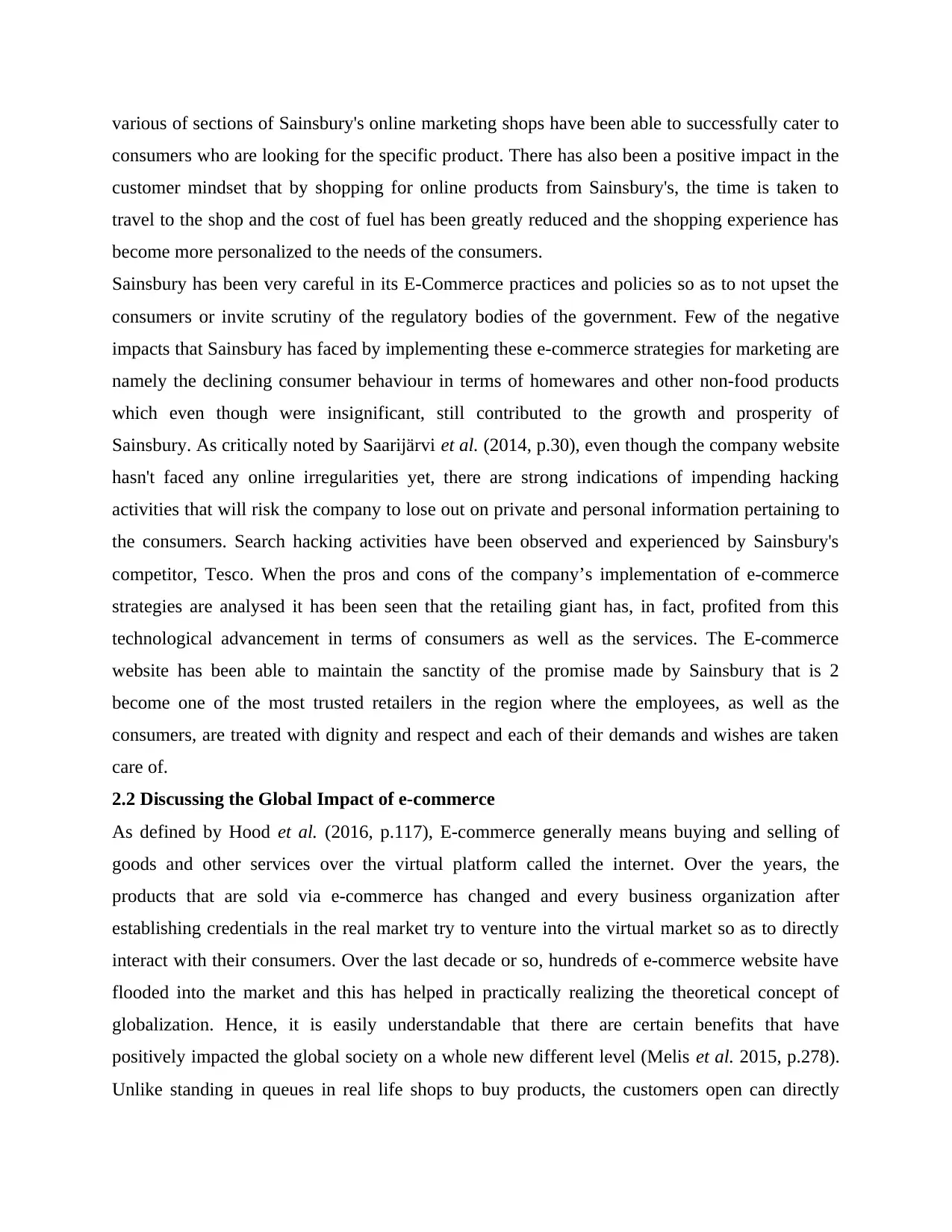
various of sections of Sainsbury's online marketing shops have been able to successfully cater to
consumers who are looking for the specific product. There has also been a positive impact in the
customer mindset that by shopping for online products from Sainsbury's, the time is taken to
travel to the shop and the cost of fuel has been greatly reduced and the shopping experience has
become more personalized to the needs of the consumers.
Sainsbury has been very careful in its E-Commerce practices and policies so as to not upset the
consumers or invite scrutiny of the regulatory bodies of the government. Few of the negative
impacts that Sainsbury has faced by implementing these e-commerce strategies for marketing are
namely the declining consumer behaviour in terms of homewares and other non-food products
which even though were insignificant, still contributed to the growth and prosperity of
Sainsbury. As critically noted by Saarijärvi et al. (2014, p.30), even though the company website
hasn't faced any online irregularities yet, there are strong indications of impending hacking
activities that will risk the company to lose out on private and personal information pertaining to
the consumers. Search hacking activities have been observed and experienced by Sainsbury's
competitor, Tesco. When the pros and cons of the company’s implementation of e-commerce
strategies are analysed it has been seen that the retailing giant has, in fact, profited from this
technological advancement in terms of consumers as well as the services. The E-commerce
website has been able to maintain the sanctity of the promise made by Sainsbury that is 2
become one of the most trusted retailers in the region where the employees, as well as the
consumers, are treated with dignity and respect and each of their demands and wishes are taken
care of.
2.2 Discussing the Global Impact of e-commerce
As defined by Hood et al. (2016, p.117), E-commerce generally means buying and selling of
goods and other services over the virtual platform called the internet. Over the years, the
products that are sold via e-commerce has changed and every business organization after
establishing credentials in the real market try to venture into the virtual market so as to directly
interact with their consumers. Over the last decade or so, hundreds of e-commerce website have
flooded into the market and this has helped in practically realizing the theoretical concept of
globalization. Hence, it is easily understandable that there are certain benefits that have
positively impacted the global society on a whole new different level (Melis et al. 2015, p.278).
Unlike standing in queues in real life shops to buy products, the customers open can directly
consumers who are looking for the specific product. There has also been a positive impact in the
customer mindset that by shopping for online products from Sainsbury's, the time is taken to
travel to the shop and the cost of fuel has been greatly reduced and the shopping experience has
become more personalized to the needs of the consumers.
Sainsbury has been very careful in its E-Commerce practices and policies so as to not upset the
consumers or invite scrutiny of the regulatory bodies of the government. Few of the negative
impacts that Sainsbury has faced by implementing these e-commerce strategies for marketing are
namely the declining consumer behaviour in terms of homewares and other non-food products
which even though were insignificant, still contributed to the growth and prosperity of
Sainsbury. As critically noted by Saarijärvi et al. (2014, p.30), even though the company website
hasn't faced any online irregularities yet, there are strong indications of impending hacking
activities that will risk the company to lose out on private and personal information pertaining to
the consumers. Search hacking activities have been observed and experienced by Sainsbury's
competitor, Tesco. When the pros and cons of the company’s implementation of e-commerce
strategies are analysed it has been seen that the retailing giant has, in fact, profited from this
technological advancement in terms of consumers as well as the services. The E-commerce
website has been able to maintain the sanctity of the promise made by Sainsbury that is 2
become one of the most trusted retailers in the region where the employees, as well as the
consumers, are treated with dignity and respect and each of their demands and wishes are taken
care of.
2.2 Discussing the Global Impact of e-commerce
As defined by Hood et al. (2016, p.117), E-commerce generally means buying and selling of
goods and other services over the virtual platform called the internet. Over the years, the
products that are sold via e-commerce has changed and every business organization after
establishing credentials in the real market try to venture into the virtual market so as to directly
interact with their consumers. Over the last decade or so, hundreds of e-commerce website have
flooded into the market and this has helped in practically realizing the theoretical concept of
globalization. Hence, it is easily understandable that there are certain benefits that have
positively impacted the global society on a whole new different level (Melis et al. 2015, p.278).
Unlike standing in queues in real life shops to buy products, the customers open can directly
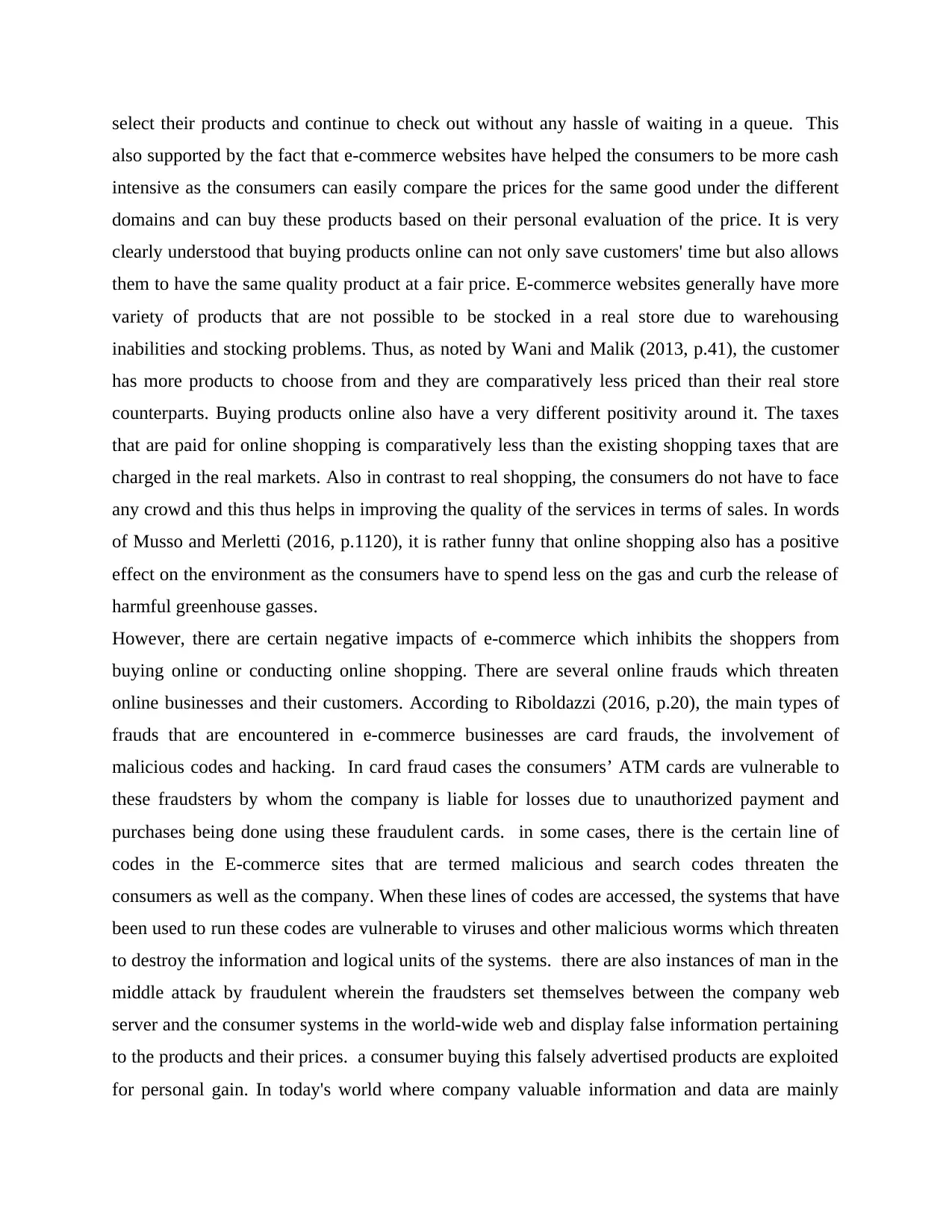
select their products and continue to check out without any hassle of waiting in a queue. This
also supported by the fact that e-commerce websites have helped the consumers to be more cash
intensive as the consumers can easily compare the prices for the same good under the different
domains and can buy these products based on their personal evaluation of the price. It is very
clearly understood that buying products online can not only save customers' time but also allows
them to have the same quality product at a fair price. E-commerce websites generally have more
variety of products that are not possible to be stocked in a real store due to warehousing
inabilities and stocking problems. Thus, as noted by Wani and Malik (2013, p.41), the customer
has more products to choose from and they are comparatively less priced than their real store
counterparts. Buying products online also have a very different positivity around it. The taxes
that are paid for online shopping is comparatively less than the existing shopping taxes that are
charged in the real markets. Also in contrast to real shopping, the consumers do not have to face
any crowd and this thus helps in improving the quality of the services in terms of sales. In words
of Musso and Merletti (2016, p.1120), it is rather funny that online shopping also has a positive
effect on the environment as the consumers have to spend less on the gas and curb the release of
harmful greenhouse gasses.
However, there are certain negative impacts of e-commerce which inhibits the shoppers from
buying online or conducting online shopping. There are several online frauds which threaten
online businesses and their customers. According to Riboldazzi (2016, p.20), the main types of
frauds that are encountered in e-commerce businesses are card frauds, the involvement of
malicious codes and hacking. In card fraud cases the consumers’ ATM cards are vulnerable to
these fraudsters by whom the company is liable for losses due to unauthorized payment and
purchases being done using these fraudulent cards. in some cases, there is the certain line of
codes in the E-commerce sites that are termed malicious and search codes threaten the
consumers as well as the company. When these lines of codes are accessed, the systems that have
been used to run these codes are vulnerable to viruses and other malicious worms which threaten
to destroy the information and logical units of the systems. there are also instances of man in the
middle attack by fraudulent wherein the fraudsters set themselves between the company web
server and the consumer systems in the world-wide web and display false information pertaining
to the products and their prices. a consumer buying this falsely advertised products are exploited
for personal gain. In today's world where company valuable information and data are mainly
also supported by the fact that e-commerce websites have helped the consumers to be more cash
intensive as the consumers can easily compare the prices for the same good under the different
domains and can buy these products based on their personal evaluation of the price. It is very
clearly understood that buying products online can not only save customers' time but also allows
them to have the same quality product at a fair price. E-commerce websites generally have more
variety of products that are not possible to be stocked in a real store due to warehousing
inabilities and stocking problems. Thus, as noted by Wani and Malik (2013, p.41), the customer
has more products to choose from and they are comparatively less priced than their real store
counterparts. Buying products online also have a very different positivity around it. The taxes
that are paid for online shopping is comparatively less than the existing shopping taxes that are
charged in the real markets. Also in contrast to real shopping, the consumers do not have to face
any crowd and this thus helps in improving the quality of the services in terms of sales. In words
of Musso and Merletti (2016, p.1120), it is rather funny that online shopping also has a positive
effect on the environment as the consumers have to spend less on the gas and curb the release of
harmful greenhouse gasses.
However, there are certain negative impacts of e-commerce which inhibits the shoppers from
buying online or conducting online shopping. There are several online frauds which threaten
online businesses and their customers. According to Riboldazzi (2016, p.20), the main types of
frauds that are encountered in e-commerce businesses are card frauds, the involvement of
malicious codes and hacking. In card fraud cases the consumers’ ATM cards are vulnerable to
these fraudsters by whom the company is liable for losses due to unauthorized payment and
purchases being done using these fraudulent cards. in some cases, there is the certain line of
codes in the E-commerce sites that are termed malicious and search codes threaten the
consumers as well as the company. When these lines of codes are accessed, the systems that have
been used to run these codes are vulnerable to viruses and other malicious worms which threaten
to destroy the information and logical units of the systems. there are also instances of man in the
middle attack by fraudulent wherein the fraudsters set themselves between the company web
server and the consumer systems in the world-wide web and display false information pertaining
to the products and their prices. a consumer buying this falsely advertised products are exploited
for personal gain. In today's world where company valuable information and data are mainly
⊘ This is a preview!⊘
Do you want full access?
Subscribe today to unlock all pages.

Trusted by 1+ million students worldwide
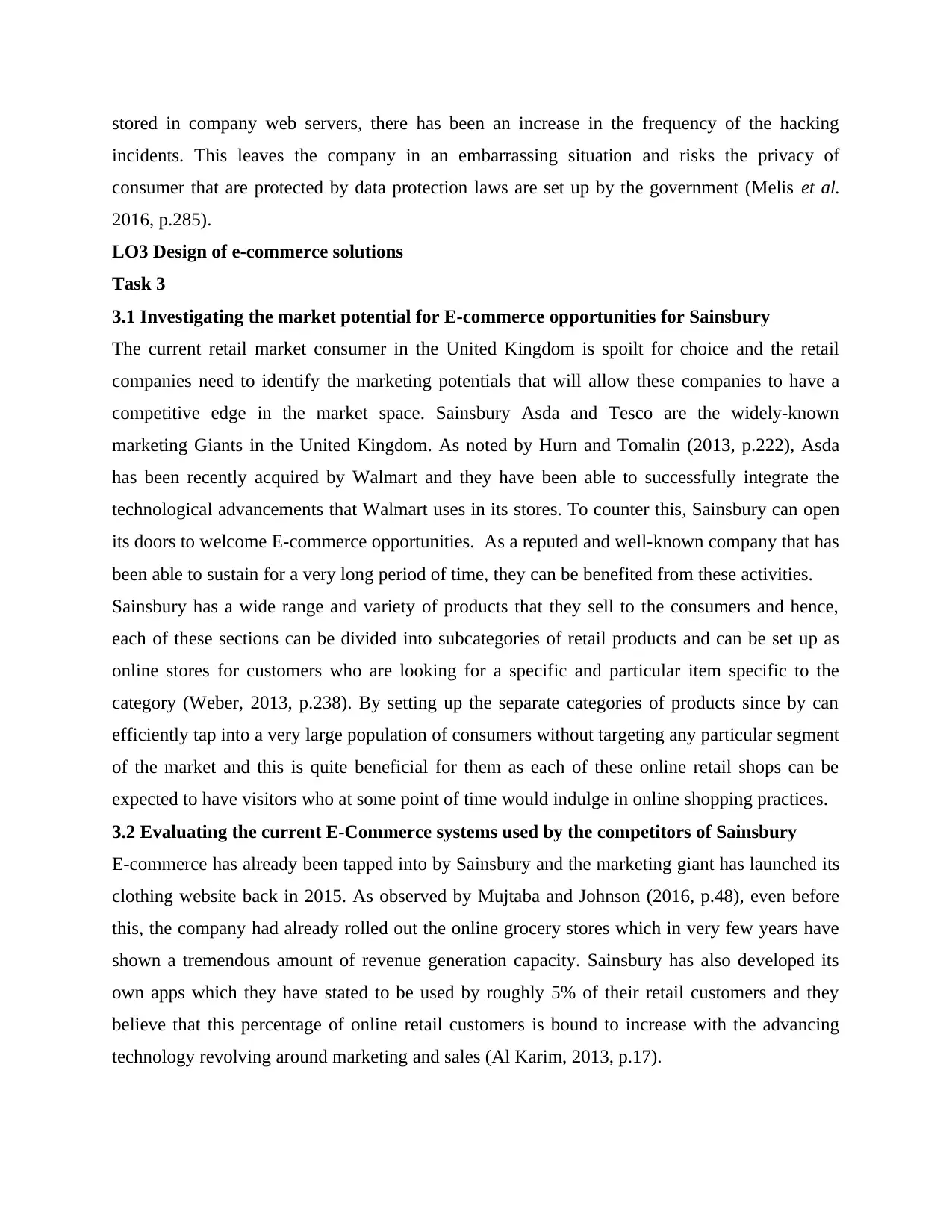
stored in company web servers, there has been an increase in the frequency of the hacking
incidents. This leaves the company in an embarrassing situation and risks the privacy of
consumer that are protected by data protection laws are set up by the government (Melis et al.
2016, p.285).
LO3 Design of e-commerce solutions
Task 3
3.1 Investigating the market potential for E-commerce opportunities for Sainsbury
The current retail market consumer in the United Kingdom is spoilt for choice and the retail
companies need to identify the marketing potentials that will allow these companies to have a
competitive edge in the market space. Sainsbury Asda and Tesco are the widely-known
marketing Giants in the United Kingdom. As noted by Hurn and Tomalin (2013, p.222), Asda
has been recently acquired by Walmart and they have been able to successfully integrate the
technological advancements that Walmart uses in its stores. To counter this, Sainsbury can open
its doors to welcome E-commerce opportunities. As a reputed and well-known company that has
been able to sustain for a very long period of time, they can be benefited from these activities.
Sainsbury has a wide range and variety of products that they sell to the consumers and hence,
each of these sections can be divided into subcategories of retail products and can be set up as
online stores for customers who are looking for a specific and particular item specific to the
category (Weber, 2013, p.238). By setting up the separate categories of products since by can
efficiently tap into a very large population of consumers without targeting any particular segment
of the market and this is quite beneficial for them as each of these online retail shops can be
expected to have visitors who at some point of time would indulge in online shopping practices.
3.2 Evaluating the current E-Commerce systems used by the competitors of Sainsbury
E-commerce has already been tapped into by Sainsbury and the marketing giant has launched its
clothing website back in 2015. As observed by Mujtaba and Johnson (2016, p.48), even before
this, the company had already rolled out the online grocery stores which in very few years have
shown a tremendous amount of revenue generation capacity. Sainsbury has also developed its
own apps which they have stated to be used by roughly 5% of their retail customers and they
believe that this percentage of online retail customers is bound to increase with the advancing
technology revolving around marketing and sales (Al Karim, 2013, p.17).
incidents. This leaves the company in an embarrassing situation and risks the privacy of
consumer that are protected by data protection laws are set up by the government (Melis et al.
2016, p.285).
LO3 Design of e-commerce solutions
Task 3
3.1 Investigating the market potential for E-commerce opportunities for Sainsbury
The current retail market consumer in the United Kingdom is spoilt for choice and the retail
companies need to identify the marketing potentials that will allow these companies to have a
competitive edge in the market space. Sainsbury Asda and Tesco are the widely-known
marketing Giants in the United Kingdom. As noted by Hurn and Tomalin (2013, p.222), Asda
has been recently acquired by Walmart and they have been able to successfully integrate the
technological advancements that Walmart uses in its stores. To counter this, Sainsbury can open
its doors to welcome E-commerce opportunities. As a reputed and well-known company that has
been able to sustain for a very long period of time, they can be benefited from these activities.
Sainsbury has a wide range and variety of products that they sell to the consumers and hence,
each of these sections can be divided into subcategories of retail products and can be set up as
online stores for customers who are looking for a specific and particular item specific to the
category (Weber, 2013, p.238). By setting up the separate categories of products since by can
efficiently tap into a very large population of consumers without targeting any particular segment
of the market and this is quite beneficial for them as each of these online retail shops can be
expected to have visitors who at some point of time would indulge in online shopping practices.
3.2 Evaluating the current E-Commerce systems used by the competitors of Sainsbury
E-commerce has already been tapped into by Sainsbury and the marketing giant has launched its
clothing website back in 2015. As observed by Mujtaba and Johnson (2016, p.48), even before
this, the company had already rolled out the online grocery stores which in very few years have
shown a tremendous amount of revenue generation capacity. Sainsbury has also developed its
own apps which they have stated to be used by roughly 5% of their retail customers and they
believe that this percentage of online retail customers is bound to increase with the advancing
technology revolving around marketing and sales (Al Karim, 2013, p.17).
Paraphrase This Document
Need a fresh take? Get an instant paraphrase of this document with our AI Paraphraser
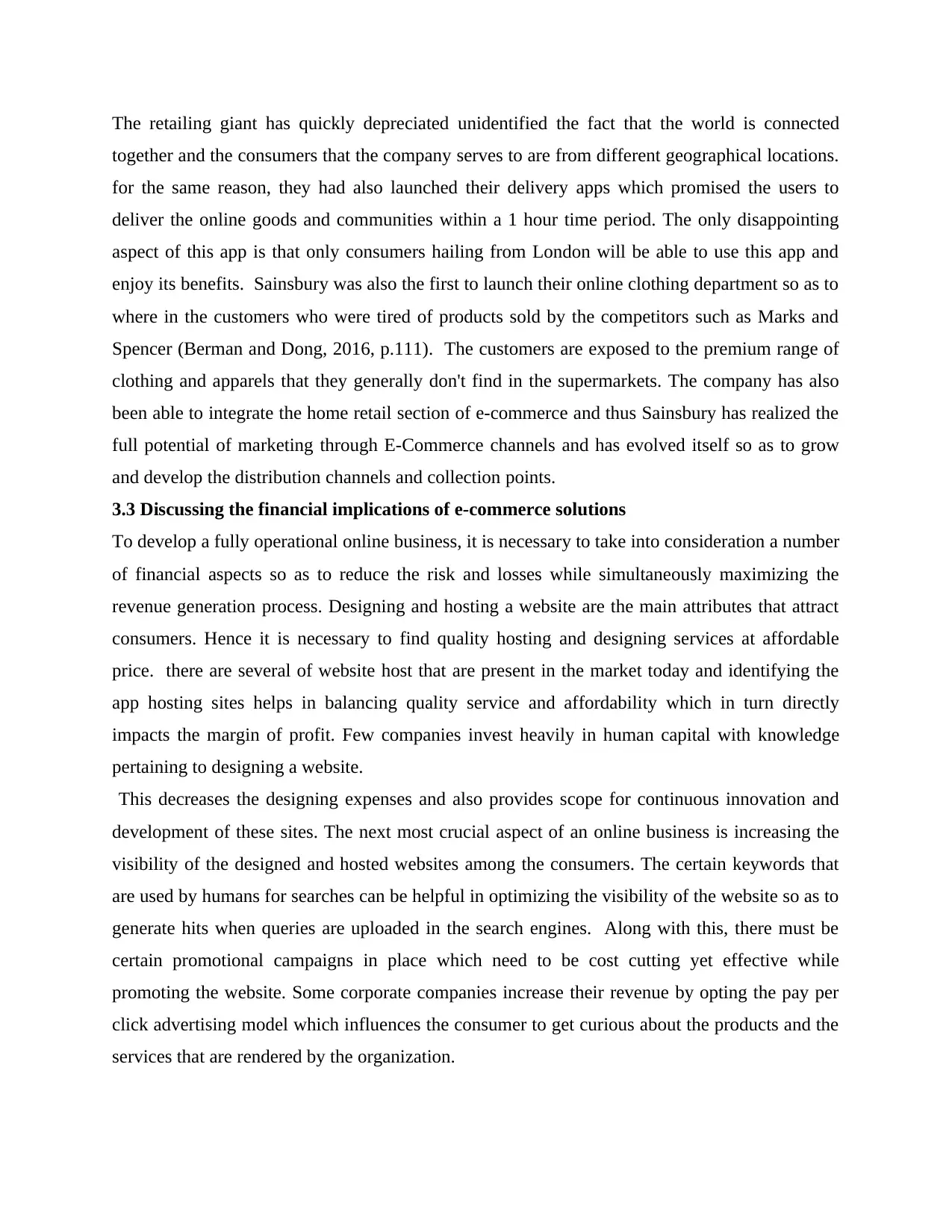
The retailing giant has quickly depreciated unidentified the fact that the world is connected
together and the consumers that the company serves to are from different geographical locations.
for the same reason, they had also launched their delivery apps which promised the users to
deliver the online goods and communities within a 1 hour time period. The only disappointing
aspect of this app is that only consumers hailing from London will be able to use this app and
enjoy its benefits. Sainsbury was also the first to launch their online clothing department so as to
where in the customers who were tired of products sold by the competitors such as Marks and
Spencer (Berman and Dong, 2016, p.111). The customers are exposed to the premium range of
clothing and apparels that they generally don't find in the supermarkets. The company has also
been able to integrate the home retail section of e-commerce and thus Sainsbury has realized the
full potential of marketing through E-Commerce channels and has evolved itself so as to grow
and develop the distribution channels and collection points.
3.3 Discussing the financial implications of e-commerce solutions
To develop a fully operational online business, it is necessary to take into consideration a number
of financial aspects so as to reduce the risk and losses while simultaneously maximizing the
revenue generation process. Designing and hosting a website are the main attributes that attract
consumers. Hence it is necessary to find quality hosting and designing services at affordable
price. there are several of website host that are present in the market today and identifying the
app hosting sites helps in balancing quality service and affordability which in turn directly
impacts the margin of profit. Few companies invest heavily in human capital with knowledge
pertaining to designing a website.
This decreases the designing expenses and also provides scope for continuous innovation and
development of these sites. The next most crucial aspect of an online business is increasing the
visibility of the designed and hosted websites among the consumers. The certain keywords that
are used by humans for searches can be helpful in optimizing the visibility of the website so as to
generate hits when queries are uploaded in the search engines. Along with this, there must be
certain promotional campaigns in place which need to be cost cutting yet effective while
promoting the website. Some corporate companies increase their revenue by opting the pay per
click advertising model which influences the consumer to get curious about the products and the
services that are rendered by the organization.
together and the consumers that the company serves to are from different geographical locations.
for the same reason, they had also launched their delivery apps which promised the users to
deliver the online goods and communities within a 1 hour time period. The only disappointing
aspect of this app is that only consumers hailing from London will be able to use this app and
enjoy its benefits. Sainsbury was also the first to launch their online clothing department so as to
where in the customers who were tired of products sold by the competitors such as Marks and
Spencer (Berman and Dong, 2016, p.111). The customers are exposed to the premium range of
clothing and apparels that they generally don't find in the supermarkets. The company has also
been able to integrate the home retail section of e-commerce and thus Sainsbury has realized the
full potential of marketing through E-Commerce channels and has evolved itself so as to grow
and develop the distribution channels and collection points.
3.3 Discussing the financial implications of e-commerce solutions
To develop a fully operational online business, it is necessary to take into consideration a number
of financial aspects so as to reduce the risk and losses while simultaneously maximizing the
revenue generation process. Designing and hosting a website are the main attributes that attract
consumers. Hence it is necessary to find quality hosting and designing services at affordable
price. there are several of website host that are present in the market today and identifying the
app hosting sites helps in balancing quality service and affordability which in turn directly
impacts the margin of profit. Few companies invest heavily in human capital with knowledge
pertaining to designing a website.
This decreases the designing expenses and also provides scope for continuous innovation and
development of these sites. The next most crucial aspect of an online business is increasing the
visibility of the designed and hosted websites among the consumers. The certain keywords that
are used by humans for searches can be helpful in optimizing the visibility of the website so as to
generate hits when queries are uploaded in the search engines. Along with this, there must be
certain promotional campaigns in place which need to be cost cutting yet effective while
promoting the website. Some corporate companies increase their revenue by opting the pay per
click advertising model which influences the consumer to get curious about the products and the
services that are rendered by the organization.
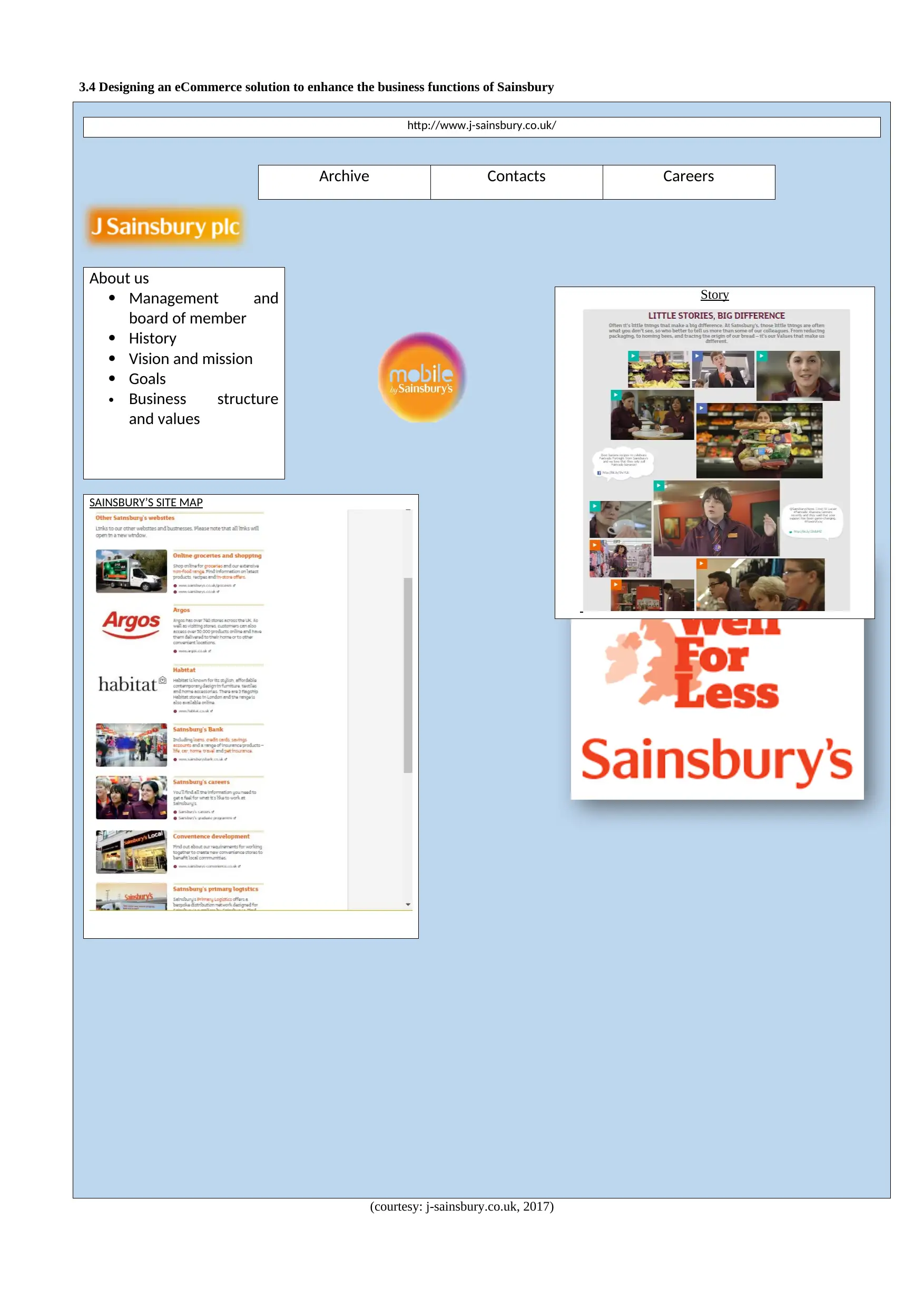
3.4 Designing an eCommerce solution to enhance the business functions of Sainsbury
http://www.j-sainsbury.co.uk/
About us
Management and
board of member
History
Vision and mission
Goals
Business structure
and values
SAINSBURY’S SITE MAP
(courtesy: j-sainsbury.co.uk, 2017)
Archive Contacts Careers
Story
http://www.j-sainsbury.co.uk/
About us
Management and
board of member
History
Vision and mission
Goals
Business structure
and values
SAINSBURY’S SITE MAP
(courtesy: j-sainsbury.co.uk, 2017)
Archive Contacts Careers
Story
⊘ This is a preview!⊘
Do you want full access?
Subscribe today to unlock all pages.

Trusted by 1+ million students worldwide
1 out of 20
Related Documents
Your All-in-One AI-Powered Toolkit for Academic Success.
+13062052269
info@desklib.com
Available 24*7 on WhatsApp / Email
![[object Object]](/_next/static/media/star-bottom.7253800d.svg)
Unlock your academic potential
Copyright © 2020–2025 A2Z Services. All Rights Reserved. Developed and managed by ZUCOL.





